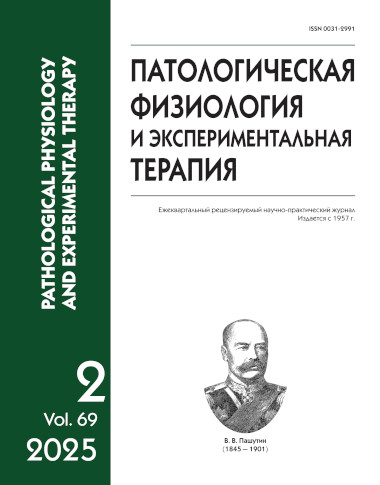The role of calcium and phosphorus metabolism in the pathogenesis of newborn cephalohematoma
Abstract
Background. A special type of complication in cephalohematomas is pathological cranial vault remodeling. It is possible to trace the dynamics of bone tissue changes in cephalohematomas based on measuring the indexes of calcium and phosphorus metabolism in the blood of newborns. Aim. To measure the serum concentration of calcium and phosphorus metabolism indexes in neonatal patients with cephalohematomas and to evaluate the dynamics of local bone changes in the projection of cephalohematoma.
Methods. The study included 90 infants observed during the newborn period; 30 of them had medium and large cephalohematomas (punctured); 30 had small cephalohematomas (not punctured); and 30 healthy infants. The concentration of calcium and phosphorus metabolism indexes was measured photometrically with an Indiko analyzer using ThermoFisher Scientific Inc. kits. Ultrasonography and local craniometry were used to record local bone changes.
Results. On days 10 and 28, the total calcium concentration in patients with medium and large cephalohematomas was 28.6‒31.5% lower than in the control group. The decrease in blood calcium in patients with medium- and large-volume cephalohematomas was not associated with a compensatory increase in parathyroid hormone and was evident in a more pronounced local osteolytic process in the projection of hemorrhage.
Conclusion. Resolution of cephalohematomas is accompanied by local bone changes that depend on calcium metabolism. Changes in the parameters of calcium and phosphorus metabolism may reflect the dynamics of local pathological cranial bone remodeling during subperiosteal hemorrhage.
Downloads
References
2. Kiosov A.F., Galiaskarova A.R. Risk factors and clinical features of the formation of cephalhematoma in newborns. Ural'skij medicinskij zhurnal. 2019; 15(183): 23-27. doi: 10.25694/urmj.2019.15.07.(in Russian)
3. Üçer M., Taçyıldız A.E., Aydın I., Akkoyun K.N., Işık S. Observational Case Analysis of Neonates With Large Cephalohematoma. Cureus. 2021; 13(4): 14415. doi: 10.7759/cureus.14415.
4. Ulma R.M., Sacks G., Rodoni B.M., Duncan A., Buchman A.T., Buchman B.C., et al. Management of Calcified Cephalohematoma of Infancy: The University of Michigan 25-Year Experience. Plast Reconstr Surg. 2021; 148(2): 409-417. doi: 10.1097/prs.0000000000008199.
5. Kiosov A.F. Kefalogematomy u detej. Lechashchij vrach. 2019; 10: 52-55. doi: 10.26295/0s.2019.61.42.010. (in Russian)
6. Mirsadykov D.A., Minozhov A.M., Abdumazhitova M.M., Mahmaev T.J. Variants of evolution calcificated kephalogematoma. Nejrohirurgiya i nevrologiya detskogo vozrasta. 2010; 2(24): 50-57. (in Russian)
7. Kopacz A., Nagy L., Demke J. Bilateral Cephalohematoma With Sagittal Synostosis and Scaphocephaly. J Craniofac Surg. 2020; 31(3): 260-261. doi: 10.1097/scs.0000000000006223.
8. Wong C.H., Foo C.L., Seow W.T. Calcified cephalohematoma: classification, indications for surgery and techniques. J Craniofac Surg. 2006; 17(5): 970-9. doi: 10.1097/01.scs.0000229552.82081.de.
9. Mudrov V.A. Algoritmy statisticheskogo analiza dannyh biomedicinskih issledovanij s pomoshch'yu paketa programm SPSS (dostupnym yazykom): Uchebnoe posobie. M.: Logosfera; 2022. 143 p.
10. Lebedeva O. V., Cherkasov N.S., Cheremina N.I. Diagnosis of osteopenia in childrens with very low and extremely low birth weight. Astrahanskij medicinskij zhurnal. 2015; 10(1): 78-84. (in Russian)
11. Klimov L.Y., Petrosyan M.A., Verisokina N.E., Kuryaninova V.A., Atanesyan R.A., Bobryshev D.V. et al. Hypovitaminosis D and osteopenia of preterm infants: risk factors and mechanisms of formation. Medicinskij vestnik Severnogo Kavkaza. 2021; 16(2): 215-221. doi: 10.14300/mnnc.2021.16051. (in Russian)
12. Papizh S.V. Hypercalcemia in children. Nefrologiya. 2020; 24(2): 42-51. doi: 10.36485/1561-6274-2020-24-2-42-51. (in Russian)
13. Mal'cev S.V., Arhipova N.N., Shakirova E.M., Kolesnichenko T.V. Features of phosphate-calcium metabolism at newborns and premature newborns. Prakticheskaya medicina. 2009; 7(39): 9-12. (in Russian)
14. Voroncova M.V., Kulebyakin K.Y., Makazan N.V, Sozaeva L. S., Tyurin-Kuz'min P. A.. Parathyroid hormone in the regulation of bone growth and resorption in health and disease. Vestnik Rossijskoj akademii medicinskih nauk. 2021; 76(5): 506-517. doi: 10.15690/vramn1440. (in Russian)
15. Arhipova N.N. Rol' tireokal'citonina i paratireoidnogo gormona v sohranenii fosfatno-kal'cievogo gomeostaza. Prakticheskaya Medicina. 2008; 27: 25-27. (in Russian)
16. Zaharova I.N., Klimov L.Y, Kas'yanova A.N., Verisokina N.E., Kur'yaninova V.A., Dolbnya S.V. et al. The parathyroid hormone level and its correlation with the supply of vitamin d in early childhood. Rossijskij vestnik perinatologii i pediatrii. 2018; 63(3): 51-58. doi: 10.21508/1027-40652018-63-3-51-58. (in Russian)
17. Marmalyuk D.A., Runova G.E., Fadeev V.V. The role of the calcium-sensing receptor in the regulation of parathyroid hormone secretion in physiology and in calcitropic diseases. Osteoporoz i osteopatii. 2023; 26(3): 25-32. doi: 10.14341/osteo13142. (in Russian)
18. Grebennikova T.A., Belaya Z.E., Mel'nichenko G.A. Hypoparathyroidism: disease update and new methods of treatment. Endokrinnaya hirurgiya. 2017; 11(2): 70-80. doi: 10.14341/serg2017270-80. (in Russian)
19. Pasieka J.L, Wentworth K., Yeo C.T., Cremers S., Dempster D., Fukumoto S. et al. Etiology and Pathophysiology of Hypoparathyroidism: A Narrative Review. J Bone Miner Res. 2022; 37(12): 2586-2601. doi: 10.1002/jbmr.4714.






